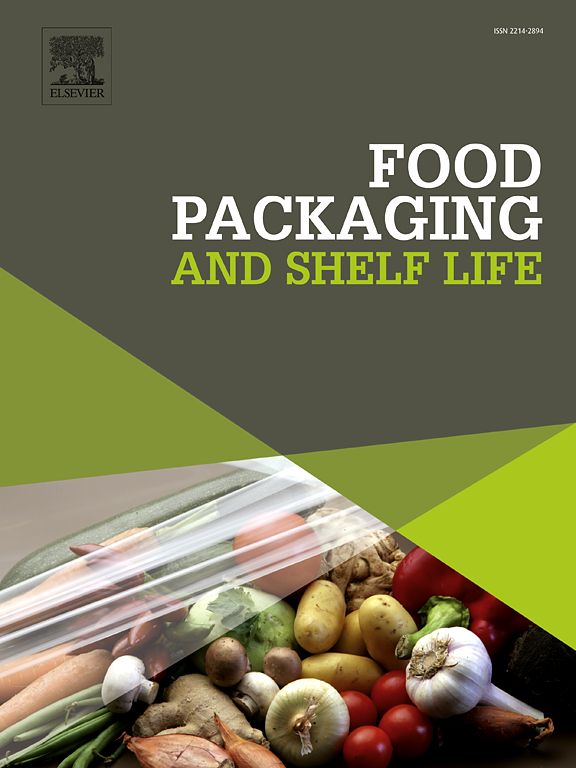研究了聚乳酸(PLA)增韧对从PLA纳米复合材料中释放石墨烯纳米板到食品模拟物中的影响
IF 10.6
1区 农林科学
Q1 FOOD SCIENCE & TECHNOLOGY
引用次数: 0
摘要
本研究探讨了石墨烯从聚乳酸(PLA)基质中的迁移,并研究了PLA增韧和增容如何影响石墨烯的释放。由于PLA具有固有的脆性和有限的柔韧性,因此使用聚烯烃弹性体(POE)来改善其机械性能并增强其在包装应用中的适用性。通过熔融挤压、成型和在不同条件下暴露于各种食品模拟剂中制备了不同含量的石墨烯、POE和马来酸酐接枝POE (POE-g- mah)的PLA和PLA/聚烯烃弹性体(POE)纳米复合材料。分析了样品与食品模拟物接触时的溶胀、溶解、降解、总迁移、石墨烯迁移以及热性能的变化。此外,还评估了释放的石墨烯的尺寸分布和结构。研究发现,石墨烯含量的增加以及POE和POE-g- mah的加入显著降低了聚合物的溶胀、溶解和石墨烯的释放。PLA/石墨烯纳米复合材料表现出最高的膨胀、降解和石墨烯迁移,而PLA/石墨烯/POE纳米复合材料表现出更高的稳定性。这种稳定性归因于增韧剂和相容剂有效地阻碍了食品模拟剂的渗透和聚合物的降解。此外,PLA基质被食品模拟物结晶,特别是50% %乙醇,导致更高的结晶度和迁移测试后的熔点增加。这些结果为提高食品接触应用中增韧PLA/石墨烯基纳米复合材料的稳定性提供了见解。本文章由计算机程序翻译,如有差异,请以英文原文为准。
Investigating the influence of polylactic acid (PLA) toughening on the release of graphene nanoplates into food simulants from PLA nanocomposite
This study explores the migration of graphene from poly(lactic acid) (PLA) matrices and examines how PLA toughening and compatibilization impact graphene release. Since PLA is inherently brittle and has limited flexibility, polyolefin elastomer (POE) is used to improve its mechanical properties and enhance its suitability for packaging applications. PLA and PLA/polyolefin elastomer (POE) nanocomposites with varying contents of graphene, POE, and POE grafted with maleic anhydride (POE-g-MAH) were prepared through melt extrusion, followed by molding and exposure to various food simulants under different conditions. The swelling, dissolution, degradation, total migration, graphene migration, and changes in thermal properties of the samples in contact with food simulants were analyzed. Additionally, the size distribution and structure of the released graphene were evaluated. It was found that higher graphene content and the addition of POE and POE-g-MAH significantly reduced polymer swelling, dissolution, and graphene release. PLA/graphene nanocomposites exhibited the highest swelling, degradation, and graphene migration, whereas enhanced stability was demonstrated by PLA/graphene/POE nanocomposites. This stability is attributed to the toughening agents and compatibilizers effectively impeding food simulant penetration and polymer degradation. Furthermore, the PLA matrix was crystallized by food simulants, particularly 50 % ethanol, resulting in a higher degree of crystallinity and an increased melting point after the migration test. Insights into improving the stability of toughened PLA/graphene based nanocomposites for food contact applications were provided by these results.
求助全文
通过发布文献求助,成功后即可免费获取论文全文。
去求助
来源期刊

Food Packaging and Shelf Life
Agricultural and Biological Sciences-Food Science
CiteScore
14.00
自引率
8.80%
发文量
214
审稿时长
70 days
期刊介绍:
Food packaging is crucial for preserving food integrity throughout the distribution chain. It safeguards against contamination by physical, chemical, and biological agents, ensuring the safety and quality of processed foods. The evolution of novel food packaging, including modified atmosphere and active packaging, has extended shelf life, enhancing convenience for consumers. Shelf life, the duration a perishable item remains suitable for sale, use, or consumption, is intricately linked with food packaging, emphasizing its role in maintaining product quality and safety.
 求助内容:
求助内容: 应助结果提醒方式:
应助结果提醒方式:


